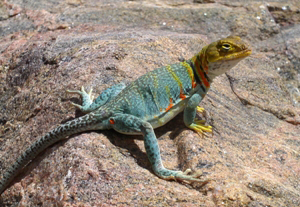The orange spots on the sides of reproductive females get very bright just before they lay eggs.
Photo Credit: Geoffrey A. Hammerson
Crotaphytus collaris
Common Name: eastern collared lizard
Other Common Names: collared lizard
Animal Guild: Reptile
Class > Order > Family: Reptilia > Squamata > Crotaphytidae
